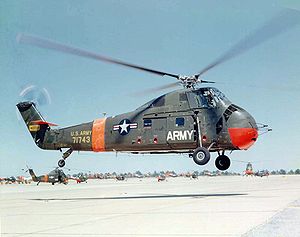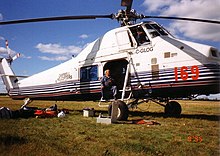Sikorsky S-58
| Sikorsky S-58 (H-34) | |
|---|---|
 A US Army Sikorsky CH-34C |
|
| Type: | Anti-submarine and transport helicopters |
| Design country: | |
| Manufacturer: | |
| First flight: |
20th September 1954 |
| Commissioning: |
August 1955 (US Navy) |
| Production time: |
1955 to 1970 |
| Number of pieces: |
approx. 2800 |
The Sikorsky S-58 was an American U-hunting and transport helicopters with piston engine . In the Air Force of the United States , the S-58 was uniformly referred to as the H-34 from 1962 . With a crew of two, the transport version could carry up to 16 passengers or 1,350 kg of cargo or eight wounded on stretchers in an ambulance.
construction
The S-58 was a main / tail rotor configuration helicopter . The fuselage was made of all-metal half - shell construction. In front of the hold - separated by a fire bulkhead - the fan-cooled nine-cylinder radial engine was mounted under a dome-shaped paneling that could be opened to the left and right.
The motor was installed with the output shaft inclined backwards and upwards. The cooling air was sucked in in the upper segment between the engine compartment and the cockpit through a series of barred openings from a space and was able to escape through openings at the bottom of the engine casing. The drive power was transmitted through a shaft running diagonally backwards upwards under the pilot's seats in accordance with the engine inclination to the main gearbox, which was mounted directly behind the pilot's cockpit and above the cargo hold.
The S-58 had a four-bladed main rotor that rotated counterclockwise when viewed from above. The rotor blades were designed in the symmetrical profile NACA 0012 . The also four-bladed tail rotor was on the left side of the raised part of the tail boom.
Both the main rotor blades and the tail boom were foldable for use on carrier ships and for transport. The cockpit was arranged in an elevated position above the hold. The fixed landing gear consisted of a broad-gauge, sprung main landing gear with exposed bracing at the front at the height of the cockpit and a tail wheel at the rear. The cargo door was on the right, the exhaust on the left.
history

In 1950 the United States Navy put the Sikorsky S-55 into service, which showed the potential of helicopters in submarine hunting. In 1953, a helicopter was therefore commissioned to replace the S-55. A greater range, a higher weapon load and equipment with a diving sonar were required . Sikorsky responded with the prototype XHSS-1 , which took off for the first time on March 8, 1954 in Bridgeport , Connecticut . The construction was similar to the S-55 , but the S-58 was significantly larger.
The first production model of the S-58 was launched on September 20 . The US Navy anti- submarine helicopter was designated the HSS-1 Seabat . The version as a transport helicopter was used by the United States Army as the H-34A Choctaw from 1955 , and from 1957 by the United States Marine Corps as the HUS-1 Seahorse . In 1962 the designation system was standardized and the S-58 was uniformly designated as the H-34. The anti-submarine versions were renamed SH-34 , the Army flew the CH-34 and the Marine Corps the UH-34 .
The helicopter tactics used in the Vietnam War - new at the time - required universally deployable machines, a criterion that the Bell UH-1 safely met. Nevertheless, a medium-sized transport helicopter was needed to transport troops and the wounded. This role was largely taken over by the S-58 . The radial engines used were actually no longer state of the art when the S-58 was introduced ; a few versions later were equipped with twin turbines of the Pratt & Whitney PT6T Turbo Twin Pac type. A total of around 2800 units of this type of helicopter were produced: Sikorsky alone had produced 1901 units, the rest is distributed among licensees from all over the world, including Westland Aircraft from Great Britain with 356 units of the Wessex .
145 copies were used as H-34G in the German Bundeswehr .
From September 1953 to 1966, the Belgian state airline Sabena initially used several SH-55s, but later SH-58s, in the civilian sector to operate helicopter routes for passengers between Belgium , the Netherlands , France and Germany from the central heliport Allée Verte in Brussels ( with heliports in Dortmund , Duisburg , Cologne and Bonn ).
Appearances in film and television
- On Screaming Mimi a pink is S-58T in the television series Riptide baptized.
- Appearance of an S-58 C in the television film about the storm surge in 1962 : The PJ-366 (D-HAUG) from Meravo Luftreederei, which was repainted to look like an army pilot especially for the RTL filming , is the only one of its type still capable of flying in Europe.
- A machine with the identification D-HAUE can be seen in episode 9 ( Hermännchen ) of Heimat - A German Chronicle by Edgar Reitz (1984).
- In the TV series Funkstreife Isar 12 from 1963, episode 27 shows a machine of the Bundeswehr with the unusual identification PH-270. However, this identifier was common in the early years of the Bundeswehr. The helicopter is an H-34G I of Army Aviation Squadron 8 (mountains).
- In episode 31 of the series The Crime Museum , an Army S-58 helicopter (PH-262, also from Army Aviation Squadron 8 Mountains) is used to rescue a fallen mountain climber.
- In season 1, episode 4 of the Z Nation series , you can see a damaged S-58 of the United States Army .
- In the 8th episode of the 16th season of Mythbusters the helicopter “Big Dawg”, an S-58ET, can be seen.
- In the final scene of the Beatles film A Hard Day's Night , a BEA S-58 is used to get the band and Paul McCartney's “grandfather” away from the concert hall.
Military versions

- CH-34A Choctaw
- Transport version of the US Navy HSS-1 for the US Army with a 1,525 HP R-1820-84 engine. 359 were built and 21 were adopted by the US Navy (before 1963 H-34A).
- JH-34A
- H-34A converted for weapon testing
- VH-34A
- H-34A converted into VIP transporters
- CH-34B
- improved details of the H-34A (before 1962 H-34B)
- CH-34C
- modified H-34A (before 1962 H-34C)
- JH-34C
- CH-34C converted for weapon testing
- VH-34C
- CH-34C converted into VIP transporters
- HH-34D
- Name for H-34s, which were built with serial numbers of the US Air Force as part of the Military Assistance Program for friendly states.
- H-34G
- H-34 of the German Armed Forces
- UH-34D Seahorse
- U.S. Marine Corps transport helicopters, 462 built (before 1962 HUS-1)
- LH-34D
- four UH-34s equipped for use in the Antarctic (before 1962 HUS-1L)
- VH-34D
- seven UH-34D (before 1962 HUS-1Z) converted as VIP transporters
- UH-34E
- 40 UH-34Ds equipped with inflatable floats (before 1962 HUS-1A)
- HH-34F
- Rescue helicopters for the United States Coast Guard , six built (before 1962 HUS-1G)
- YSH-34G Seabat
- three prototypes for the US Navy (before 1962 YHSS-1)
- SH-34G
- Anti-submarine version, 215 were built (before 1962 HSS-1)
- SH-34H
- a SH-34G equipped with YT-58-GE engines (before 1962 HSS-1F)
- YSH-34J
- Prototype of an all-weather anti-submarine version with improved avionics and autopilot, conversion from SH-34G (before 1963 YHSS-1N)
- SH-34J
- Production version of the YSH-34J, 167 were built, 75 were built analogously to the CH-34C for the German armed forces (before 1962 HSS-1N)
- UH-34J
- SH-34J converted into training or transport helicopters without anti-submarine equipment
- HH-34J
- SH-34J converted into rescue helicopters for the US Air Force
- VH-34J
- SH-34J converted into VIP transporters
- Westland Wessex
- Licensed buildings and further developments
Military users
-
 Cambodia
Cambodia
-
 Canada
Canada
-
 Katanga : 2
Katanga : 2 -
 Laos
Laos
-
 Netherlands
Netherlands
-
 Nicaragua
Nicaragua
-
 Philippines
Philippines
-
 Peru
Peru
-
 Taiwan
Taiwan
-
 South Vietnam : 34 CH-34
South Vietnam : 34 CH-34 -
 Spain
Spain
-
 Turkey
Turkey
-
 Thailand
Thailand
-
 Uruguay
Uruguay
-
 United States
United States
- United States Air Force
- United States Army
- United States Marine Corps
- US Navy
- United States Coast Guard
Technical data UH-34D
| Parameter | Data |
|---|---|
| Manufacturer | Sikorsky Aircraft Corporation |
| crew | 2 |
| Passengers | 16 |
| Rotor diameter | 17.07 m |
| Hull length | 14.25 m |
| Length over all | 20.00 m |
| height | 4.86 m |
| Preparation mass | 3,815 kg |
| Takeoff mass | 6,050 kg |
| crew | 2 |
| Top speed | 216 km / h |
|
Hover altitude with ground effect |
1,495 m |
| Service ceiling | 3,200 m |
| Range | 450 km |
| Engine | 1 Wright R-1820 -84D- radial engine with 1121.6 kW (1525 PS) |
Armament
Gun cases can be attached to the side hangers. Mountings for movable machine guns can be mounted in the doors and windows.
- Internal (mounted on a swiveling rotating ball mount):
- 1 × 7.62 mm US Ordnance M60A machine gun with several belt boxes of 100 rounds of ammunition each
- External (unguided air-to-surface missiles on two external load carriers):
- 2 × XM-4 weapon system consisting of 1 × rocket tube launch container for several unguided FFAR air-to-ground hydra rockets; Caliber 70 mm / 2.75 inch
- 2 × TK-1 weapon system consisting of
- 2 × 7.62 mm US Ordnance M60C machine gun with 500 rounds of ammunition and
- 1 × rocket tube launch container for 19 × unguided FFAR air-to-ground hydra missiles; Caliber 70 mm / 2.75 inch
See also
Web links
Individual evidence
- ↑ Airfoil Guide of the Department of Aerospace Engineering / College of Engineering at the University of Illinois in Urbana-Champaign ( Memento of the original from April 20, 2010 in the Internet Archive ) Info: The archive link was automatically inserted and not yet checked. Please check the original and archive link according to the instructions and then remove this notice. (English)
- ↑ World Air Forces - Katanga Aircraft ( Memento from February 19, 2002 in the Internet Archive ) accessed on March 8, 2012




